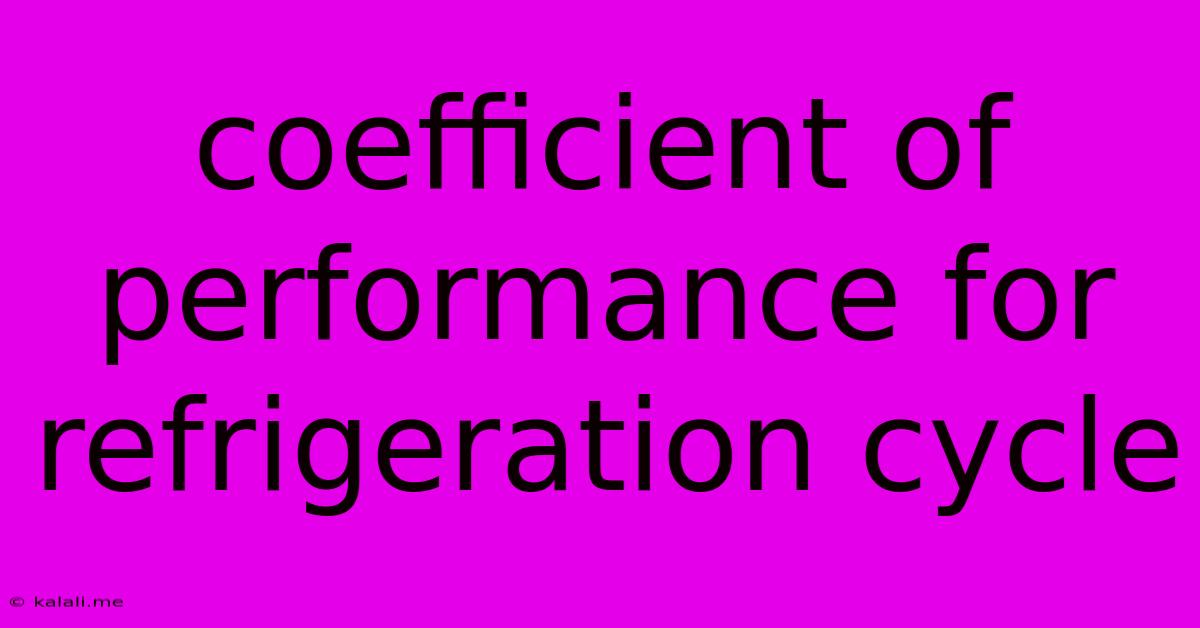Coefficient Of Performance For Refrigeration Cycle
Kalali
Jun 04, 2025 · 3 min read

Table of Contents
Understanding the Coefficient of Performance (COP) for Refrigeration Cycles
The efficiency of a refrigeration cycle is not measured by efficiency in the traditional sense (like a heat engine). Instead, we use the Coefficient of Performance (COP). This article will delve into the COP for refrigeration cycles, explaining what it is, how it's calculated, and the factors that influence its value. Understanding COP is crucial for optimizing refrigeration systems and minimizing energy consumption.
What is the Coefficient of Performance (COP)?
The COP of a refrigeration system represents the ratio of the desired cooling effect (heat removed from the cold space) to the work input required to achieve that cooling. In simpler terms, it tells us how much cooling we get for every unit of energy we put into the system. A higher COP indicates a more efficient refrigeration system. The higher the COP, the less energy is consumed for the same amount of cooling. This is a critical factor in both residential and industrial applications, directly impacting energy bills and environmental impact.
Calculating the Coefficient of Performance
The COP is calculated using the following formula:
COP = Cooling Effect (Q<sub>c</sub>) / Work Input (W)
Where:
- Q<sub>c</sub> is the heat absorbed from the cold reservoir (the space being cooled). This is also known as the refrigeration effect.
- W is the work done by the compressor (the energy input to the system).
Factors Affecting the Coefficient of Performance
Several factors influence the COP of a refrigeration cycle. Optimizing these factors is key to achieving high efficiency:
-
Refrigerant Type: Different refrigerants have varying thermodynamic properties, impacting the efficiency of the cycle. Modern refrigerants are designed to maximize COP while minimizing environmental impact. Research into new refrigerants is ongoing to further improve efficiency and reduce global warming potential.
-
Operating Temperatures: The temperature difference between the evaporator (cold space) and the condenser (hot space) significantly affects COP. A smaller temperature difference leads to a higher COP. This is why proper insulation and efficient heat exchangers are crucial. Understanding the ideal temperature ranges for optimal operation is also critical for engineers.
-
Compressor Efficiency: The compressor is the heart of the refrigeration system, consuming most of the energy. An efficient compressor is vital for maximizing COP. Advances in compressor technology, such as variable-speed compressors, contribute to significant efficiency gains.
-
Heat Exchanger Design: Efficient heat exchangers in both the evaporator and condenser minimize energy losses and maximize heat transfer, directly contributing to a higher COP. Optimal design, including surface area, flow rates, and material selection, are crucial aspects of heat exchanger optimization.
-
System Leaks: Leaks in the refrigerant circuit lead to reduced refrigerant charge, directly impacting the system’s ability to transfer heat and consequently lowering the COP. Regular system maintenance is essential to prevent leaks and maintain optimal performance.
Improving the Coefficient of Performance
Several strategies can be employed to enhance the COP of a refrigeration cycle:
-
Employing Advanced Control Systems: Precise control over compressor speed and refrigerant flow can significantly optimize the system's operation and improve COP.
-
Implementing Optimized Design and Manufacturing Techniques: Improving the design of components such as compressors and heat exchangers, utilizing high-quality materials and precise manufacturing, all play crucial roles in maximizing COP.
-
Utilizing innovative Refrigerants: Ongoing research into environmentally friendly and efficient refrigerants continues to provide better alternatives and optimize refrigeration cycles for improved performance.
Conclusion
The Coefficient of Performance is a vital metric for evaluating the efficiency of refrigeration systems. Understanding the factors that influence COP and implementing strategies to improve it are crucial for energy conservation, reducing operating costs, and minimizing the environmental footprint of refrigeration technologies. The continuous development of more efficient refrigerants and system designs promises even higher COPs in the future.
Latest Posts
Latest Posts
-
What Is The Opposite Of An Acid
Jun 06, 2025
-
What Does Sudo Do In Discord
Jun 06, 2025
-
Receiving Mail For Someone Else At My Address
Jun 06, 2025
-
Logic Gate That Flips Its Input
Jun 06, 2025
-
Main Water Shutoff Valve From Well
Jun 06, 2025
Related Post
Thank you for visiting our website which covers about Coefficient Of Performance For Refrigeration Cycle . We hope the information provided has been useful to you. Feel free to contact us if you have any questions or need further assistance. See you next time and don't miss to bookmark.